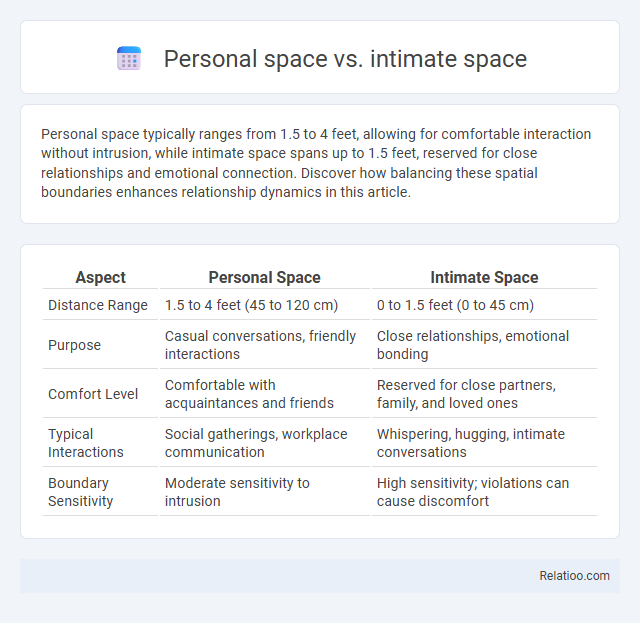Personal space typically ranges from 1.5 to 4 feet, allowing for comfortable interaction without intrusion, while intimate space spans up to 1.5 feet, reserved for close relationships and emotional connection. Discover how balancing these spatial boundaries enhances relationship dynamics in this article.
Table of Comparison
| Aspect | Personal Space | Intimate Space |
|---|---|---|
| Distance Range | 1.5 to 4 feet (45 to 120 cm) | 0 to 1.5 feet (0 to 45 cm) |
| Purpose | Casual conversations, friendly interactions | Close relationships, emotional bonding |
| Comfort Level | Comfortable with acquaintances and friends | Reserved for close partners, family, and loved ones |
| Typical Interactions | Social gatherings, workplace communication | Whispering, hugging, intimate conversations |
| Boundary Sensitivity | Moderate sensitivity to intrusion | High sensitivity; violations can cause discomfort |
Understanding Personal Space: Definition and Importance
Personal space refers to the physical distance individuals maintain between themselves and others to feel comfortable and secure, typically ranging from 1.5 to 4 feet. Intimate space is much closer, extending up to 18 inches, reserved for close relationships such as family and close friends, where physical contact or whispered communication occurs. Understanding your personal space is crucial for respecting boundaries, enhancing social interactions, and preventing discomfort or anxiety in various social settings.
Intimate Space: What It Means and Why It Matters
Intimate space, typically ranging from 0 to 18 inches, is the closest personal zone reserved for close relationships like family, partners, and close friends, highlighting the importance of trust and emotional connection. Understanding intimate space helps you navigate social dynamics and fosters respectful interactions by recognizing boundaries that signal comfort or discomfort. Respecting intimate space is crucial for maintaining healthy relationships and effective communication.
Key Differences Between Personal Space and Intimate Space
Personal space typically ranges from 18 inches to 4 feet and is the physical distance maintained during casual interactions, whereas intimate space is much closer, usually within 6 to 18 inches, reserved for close relationships and emotional connection. Your comfort level determines how these spaces are respected, with personal space allowing for casual communication and intimate space enabling deep emotional bonding. Understanding the key differences helps you navigate social interactions by recognizing when to maintain distance or allow closeness.
The Psychology Behind Spatial Boundaries
The psychology behind spatial boundaries involves understanding how different zones like personal space, intimate space, and social space regulate human interaction and emotional comfort. Your intimate space, typically 0 to 18 inches, is reserved for close relationships and conveys trust and affection, while personal space extends from 18 inches to 4 feet, allowing comfortable interaction with friends and acquaintances. Social space, ranging from 4 to 12 feet, provides a buffer for professional or casual encounters, reflecting how spatial boundaries influence psychological well-being and social dynamics.
Cultural Influences on Personal and Intimate Space
Cultural influences significantly shape personal and intimate space, with variations in acceptable proximity depending on social norms and practices. In cultures with high-context communication like Japan, intimate space is often smaller, requiring close physical distance for trusted relationships, while Western cultures typically maintain larger personal space boundaries. Understanding these cultural differences is essential for respectful social interactions and avoiding discomfort or misunderstandings in cross-cultural settings.
The Role of Body Language in Space Perception
Body language plays a crucial role in distinguishing personal space, intimate space, and social space by signaling comfort levels and intentions through posture, eye contact, and gestures. In intimate space, typically within 18 inches, close physical proximity combined with softened body language conveys trust and emotional closeness. Personal space, roughly 18 inches to 4 feet, is maintained by open but controlled body language, signaling readiness for casual interaction while respecting boundaries.
Personal Space in Social and Professional Settings
Personal space in social and professional settings typically ranges from 18 inches to 4 feet, serving as a buffer zone that maintains comfort and respects boundaries. This spatial preference helps prevent discomfort and fosters effective communication by allowing individuals to feel secure and unthreatened. Understanding and respecting personal space differences enhances interactions, reduces misunderstandings, and promotes positive relationships in both social and workplace environments.
Intimate Space in Relationships: Navigating Boundaries
Intimate space in relationships refers to the closest physical proximity, typically within 0 to 18 inches, where personal interactions involve deep emotional connection and trust. Navigating boundaries in this space requires sensitivity to a partner's comfort levels and nonverbal cues, ensuring respect for privacy and emotional safety. Understanding and honoring intimate space fosters stronger bonds and effective communication between partners.
Common Violations and Their Consequences
Common violations of personal, intimate, and social spaces often lead to discomfort, stress, and a breakdown in communication. Intrusions into intimate space, typically reserved for close relationships within 6-18 inches, can cause anxiety and distrust, while breaches of personal space (1.5 to 4 feet) may result in unease and conflict during social interactions. Social space violations, occurring beyond 4 feet in casual or public settings, often provoke irritation and negatively impact professional or casual relationships.
Tips for Respecting and Managing Spatial Boundaries
Respecting spatial boundaries requires recognizing that intimate space ranges from 0 to 18 inches and is reserved for close relationships, while personal space extends from 18 inches to 4 feet for casual interactions. Effective tips include maintaining appropriate distances based on context, observing body language cues, and asking for consent before entering someone's intimate zone. Using clear communication and situational awareness helps prevent discomfort and fosters respectful interpersonal interactions.

Infographic: Personal space vs Intimate space
 relatioo.com
relatioo.com